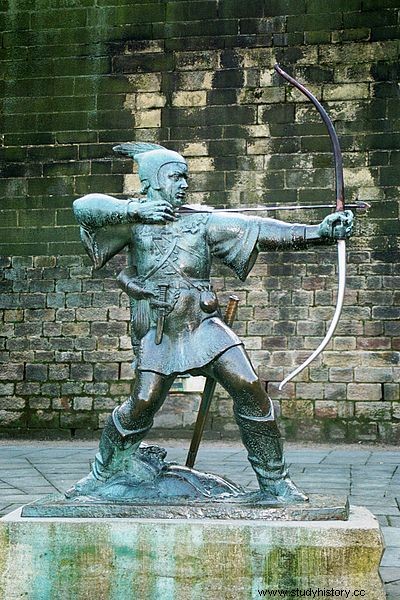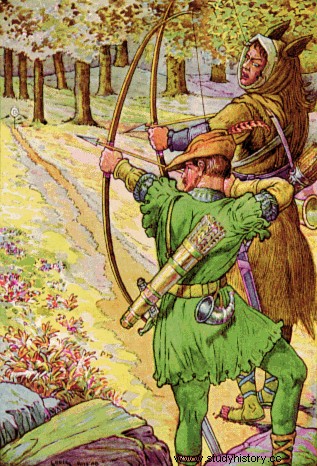An unmatched archery champion, devoted to King Richard the Lionheart, leader of the forest team fighting the wicked sheriff of Nottingham. Since the Middle Ages, the legend of the hero of the poor captivates and fascinates entire generations.
The character of Robin Hood has evolved over the centuries until it was formed in contemporary literature. Thus, from the image of a peasant or trader, after 1598 Robin became Robert, Earl of Huntington by the king. Many ask themselves - did he really exist or is he just a figment of human imagination, created for the current needs of society?
Stories straight from the Middle Ages
The first known mention of Robin Hood dates back to 1377. In the medieval English poem Widzenie o Piotr Oraczu by William Langland, the words are: I know songs about Robin Hood . We learn more about the legendary outlaw in Original Chronicle of Scotland , written in 1420. The author of the chronicle, Andrew de Wyntoun, places the fate of Robin Hood and Little John between 1283 and 1285. He presents them as well-known outlaws from Barnsdale, Yorkshire.
Walter Bower, on the other hand, in Scotichronicon lists the heroes of the legend in 1266. Like de Wyntoun, they live in the woods of Barnsdale, north of their permanent residence, Sherwood Forest in Nottinghamshire.

Robin Hood continues to inspire today
Many ballads tell about the fate of Robin and his companions, including: Robin Hood, and the potter , Robin Hood and the Curt , Robin Hood, his death . Particularly noteworthy is the ballad A gesture of Robin Hood from which a lot of inspiration was drawn after 1500. Here, too, the heroes of the legend live in the forests of Barnsdale, and their adventures take place this time around 1450.
Only in History of greater Britain from 1521 by John Major, the story of the famous outlaw takes place in the years 1193 - 1194, in the time of Richard the Lionheart. It was this version that gained the greatest popularity. Here, reference can be made, for example, to the book Robin Hood et la forêt de Sherwood by James C. Holt in 1982.
Where did the inspiration come from?
The question is, where did the authors of the Robin Hood legend get their inspiration from? It is possible that they drew from tales much older, similar to the one about Robin. One of them is about Hereward's adventures. He led a gang of outlaws in the fight against William the Conqueror . He wrote about his achievements, among others Geoffrey Gaimar. The next story from the beginning of the 12th century tells the story of Fulk Fitz Warin, a young knight who had his lands confiscated. He was supposed to run away to the forest and start an outlaw life there, while testing the honesty of the rich he detained on the highways.

The character of Robin Hood is alive in popular culture
There are other clues about the Robin Hood legend as well. Although English sources from the 13th and 14th centuries contain numerous references to people with the surname Hood, such as the names Robert and Robin, very popular at the time, some of them attract attention. One such person is Robert Hod of Yorkshire, who was recorded in court as a fugitive in 1226. Another person is Robert Hood, born in 1280, son of the forester Adam Hood. According to some of the ballads, this is the name of the father of the famous outlaw and that is what he did. Mentioned Robert lived with his wife Matilda in Wakefield, Yorkshire, about eighteen kilometers from the Barnsdale Woods.
The next clue could be court documents where the terms "Robinhood" or "Robehood" meant the outlaws . An example is the case of William de Fevre of Enborne in Berkshire. Court documents from Reading in 1261 identified him as "outlawed." And in the following year, he was already documented as William Robehood.
So, there is no strong evidence of this - one of a kind - flesh and blood Robin Hood. The adventures of the fearless Sherwood archer are part of a legend that lives on in modern culture.
